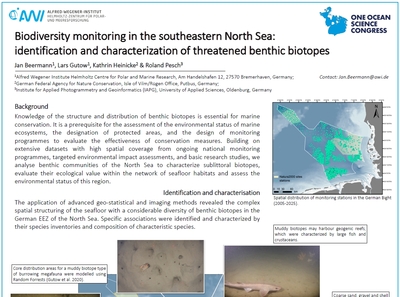Biodiversity monitoring in the southeastern North Sea: identification and characterization of threatened benthic biotopes
 ORCID: https://orcid.org/0000-0001-5894-6817, Gutow, Lars
ORCID: https://orcid.org/0000-0001-5894-6817, Gutow, Lars  ORCID: https://orcid.org/0000-0002-9017-0083, Heinicke, Kathrin and Pesch, Roland
;
ORCID: https://orcid.org/0000-0002-9017-0083, Heinicke, Kathrin and Pesch, Roland
;
<jats:p>Knowledge of the structure and distribution of benthic biotopes is essential for marine conservation. It is a prerequisite for the assessment of the environmental status of marine ecosystems, the designation of protected areas, and the design of monitoring programmes to evaluate the effectiveness of conservation measures. Building on extensive datasets with high spatial coverage from ongoing national monitoring programmes, targeted environmental impact assessments, and basic research studies, we analysed benthic communities of the North Sea to characterize sublittoral biotopes and evaluate their ecological value within the network of seafloor habitats in this region. The application of advanced geo-statistical methods revealed the complex spatial structuring of the seafloor with a considerable diversity of benthic biotopes. Specific infauna associations were identified and characterized by their species inventories and composition of characteristic species. Supposedly isolated biotopes shared common features, highlighting connectivity which may crucially enhance their resilience against disturbance. Further, the distribution of key species demonstrated substantial contribution of some biotopes to ecosystem functioning. Our extensive monitoring of the biodiversity of benthic species communities and habitats essentially improved our understanding of the structure and functioning of the North Sea ecosystem, supporting the development and implementation of management tools and conservation measures in the face ongoing environmental change and anthropogenic disturbances.</jats:p>
 ORCID: https://orcid.org/0000-0001-5894-6817, Gutow, Lars
ORCID: https://orcid.org/0000-0001-5894-6817, Gutow, Lars  ORCID: https://orcid.org/0000-0002-9017-0083, Heinicke, Kathrin and Pesch, Roland
;
ORCID: https://orcid.org/0000-0002-9017-0083, Heinicke, Kathrin and Pesch, Roland
;
Helmholtz Research Programs > CHANGING EARTH (2021-2027) > PT6:Marine and Polar Life: Sustaining Biodiversity, Biotic Interactions, Biogeochemical Functions > ST6.1: Future ecosystem functionality
![[thumbnail of OOS_Beermann_etal.jpg]](https://epic.awi.de/60175/1.hassmallThumbnailVersion/OOS_Beermann_etal.jpg)



